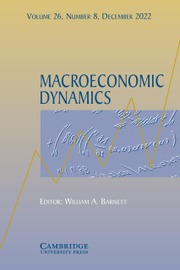Article contents
TWO NEW KEYNESIAN THEORIES OF STICKY PRICES
Published online by Cambridge University Press: 01 March 2000
Abstract
Two alternative theories of aggregate supply,both with a New Keynesian “flavor,” are compared. Thefirst assumes that prices are rigid due to theexistence of menu costs. The second derives price stickinessendogenously as one equilibrium in an economy with multiple equilibria. Inboth cases I show that the Ball–Romer concept of realrigidities is essential to explain why monetary policy has real persistenteffects. I argue that dynamic menu cost models are determinate because theymake special assumptions about the way that money enters the economy. Forexample, most authors assume either a cash-in-advance constraint or thatmoney enters separably into utility or production functions. Once one movesbeyond these special cases, menu cost models that display real rigidity arealso likely to display indeterminacy.
Keywords
Information
- Type
- HONORARY LECTURE
- Information
- Copyright
- © 2000 Cambridge University Press
- 10
- Cited by

